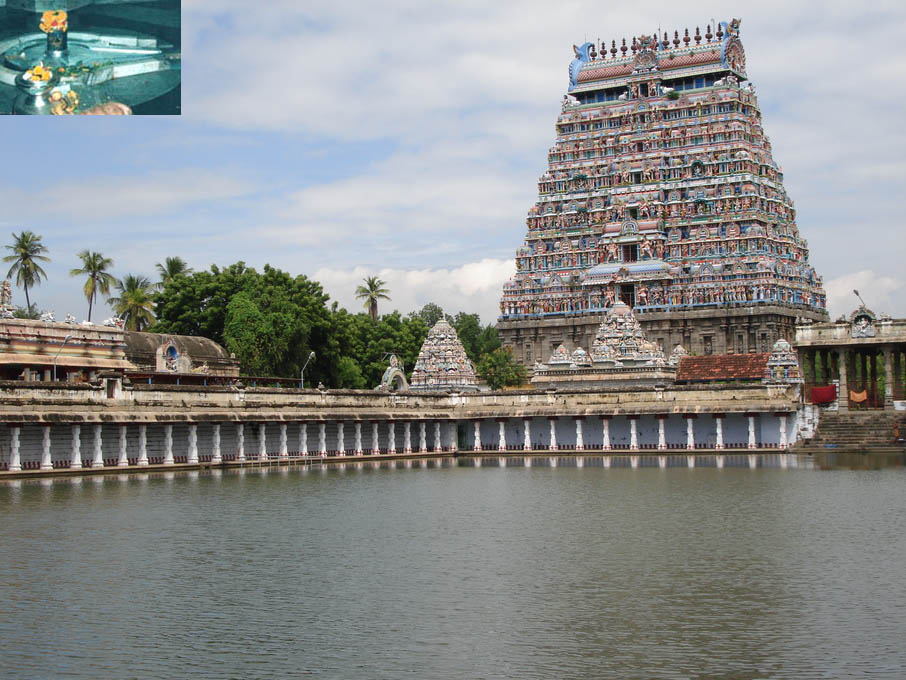Name of the Temple |
|
Location |
- Mylapore, a suburb of Chennai in the Indian state of Tamil Nāḍu
|
| How to reach there? |
- By Air: The Chennai airport is 15 km away from Kapālīśhwara temple.
- By Train: The nearest railway station is Egmore railway station, 7 km north of Kapālīśhwara.
- By Road: Chennai is connected by the National Highway 32 from Chennai to Nagapattinam, 4 from Chennai to Pune, 16 from Chennai to Vijayawāḍā and 716 from Ananthpur to Chennai.
|
Rulers/builders and Time Period |
- The commonly held view is that the temple was built in the 7th century CE by the ruling Pallavas. This view is based on references to the temple in the hymns of the Nayanmars (which, however, place it by a sea shore). Thirugnanasambandar's 6th song in Poompavaipathikam and Arunagirinathar's 697th song in Thirumylai Thirupugazh, make clear reference to the Kapalīśhwarar temple being located on the seashore in Mylapore.
- The architecture of the temple, however, appears to be 300–400 years old.
- The scholarly view that accounts for the discrepancies is that the original temple was built on the shore at the location of the current Santhome Church but was destroyed by the Portuguese and the current temple (which is 1-1.5 km from the shore) was built by the Vijayanagar kings during the 16th century.
- The temple's 120 ft gopuram (gateway tower) was built during 1906 with staccato figures adorning it.
|
Deity/Deities |
- It is a temple of Śhiva . The form of Śhiva's wife Pārvathi worshipped at this temple is called Karpagāmbāl (from Tamil, "Goddess of the Wish-Yielding Tree").
- Presiding deity – Kapalīśhwarar. Goddess - Karpagavalli.
- Navagraha and Śhaivite Nāyanmārs are consecrated in a separate enclosure.
- Lord Śhanīśhwarar is also installed in a separate sanctum sanctorum.
|
Architecture Style |
- The Kapalīśhwarar temple is of typical Dravidian architectural style, with the gopuram overpowering the street on which the temple sits.
- This temple is also a testimonial for the vishwakarmas sthapathis. There are two entrances to the temple marked by the gopuram on either side. The east gopuram is about 40 m high, while the smaller western gopuram faces the sacred tank.
- The vahanas (Sanskrit for "vehicles") at the temple include the bull, Adhhikāranandhi, elephant, bandicoot, peacock,
goat and parrot, while a golden chariot is a recent addition. Statues of the god and the goddess are seated on a vāhana, which is brought in a procession around the temple while the temple band plays music. Devotees gather around the vāhanas and consider it a privilege to pull / lift the God and the Goddess on the vāhana.
|
Other Special Features |
- This sacred spot is also called Vedhapuri. A demon Somuka wanted to learn Vedhas and harassed the celestial beings. He snatched the Vedhas and disappeared in the sea.
- Śhiva, directed Mahāviṣhṇu to restore the Vedhas. Accordingly Mahāviṣhṇu killed the demon and restored the Vedhas which was taken to this temple. Since the Vedhas were brought to this place it is called Vedhapuri.
- Lord Mahāviṣhṇu disguised as a poor Brahmin appeared before King Mahābali and asked for three feet of earth –Mūndru aḍi maṇ. The king readily agreed to this and took out his kamanḍala to pour water on earth as a token of granting the request. But his minister, Guru Śhukrāchārya knew the identity of the poor Brahmin and dissuaded the king from granting the land.
- The king turned a deaf ear to Śhukrāchārya who took the form of a fly and blocked the nozzle of the kamanḍala to prevent the flow of water. Mahaviṣhṇu at once pierced the nostril with a darbhha grass to facilitate the flow of water.
- In this act Śhukrāchārya lost one eye and proceeded to Mylapore. His vision was restored and he attained salvation. Thus Mylapore is also called Śhukrapuri.
|
Other Special Remarks |
- There is an interesting story linked with the Brahmothsavam of this temple.
- Sivanesa Chettiar of Mylapore was a staunch devotee of Śhiva whose daughter Angampūmpāvai was bitten by a cobra and died. The chettiar after cremating her collected her bones and placed it in an urn. Thirugnyāna sambandhar the saint poet who was on a pilgrimage to Mylapore visited Sivanesan Chettiar who narrated the sad tale of his daughter s death. Thirugnyānasambandhar at once sprinkled the holy water from the temple tank on the urn containing the bones of the girl and miraculously, the girl was brought back to life.
- As a token of gratitude Chettiar offered his daughter in marriage to Thirugnyānasambandhar r who declined saying that since he restored her life she is like his daughter. This incident is celebrated during the 8th day of Brahmothsavam.
- Pradoṣham is observed with piety when devotees throng the temple to have a darshan of the Lord.
- Śhivarāthri is observed with austerity and special pūjās are done throughout the night. Aruvathi mūvar which is celebrated during March and April is carnival time.
- The weeklong festival attracts devotees from far off places to have a rendezvous with Gods who are taken out in a procession.
|
Special Reference to Performing Arts: |
- There earliest mention about the temple found in 6th century Sangam literature. The temple and the deity were immortalized in Tamil poetry in the works of Thevāram.
- The 12th century poet, Guṇavīra Pandithar sings about Nemināthan under Thīrthānkar neminathar pugazh. Tirumayilai Prabanthangal is a compilation of four works on the temple and the deity.
- Thirugnyāna Sambanthar has composed the 6th Pūmpāvai pathigam in praise of the temple.
- Arunagiriṇāthar, the 15th century poet, sings praise of the temple in Thirumayilai Thirupugazh
- The famous Tamil hymns Karunai Deivame Karpagame and Karpagavalli Nin Porpadhangal Pidithen were written by poets in praise of the goddess Karpagambal.
|
Bibliography |
|















